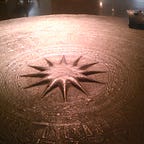Old Sundanese 101: VI — A Bunch of Aksaras
This post is the sixth in a series on the Old Sundanese language. For earlier posts in the series, see: · PART I · PART II · PART III · PART IV · PART V ·
Patreon: https://www.patreon.com/indomedieval
Ko-Fi: ko-fi.com/medievalindonesia
This post is about the skeleton of the Old Sundanese script. Here I’ve included tables of all the ‘naked’ aksaras (aksara ngalagena) and ‘vowel’ aksaras (aksara swara) — the most important elements in the script, the things that the diacritics (rarangken/sandhangan) modify. We’ve seen quite a few of them already, and some of the diacritics too, but here they are, all in one place. In the next post I’ll do the same thing with the remaining diacritics.
It may not seem like it to those of you familiar only with the Roman alphabet, but this is actually a fairly simple script. It’s easier to learn than any of the individual scripts used to write Old Javanese. It has fewer characters overall, and all the sounds that occur in the script and in Old Sundanese texts in general are easy to pronounce if you know English. There are fewer diacritics than you’ll find in Old Javanese scripts — fewer vowels, fewer consonants, and fewer paired characters. There are no long vowels or retroflex consonants. If you were to learn one script to start to get a handle on early Indo-Malaysian manuscripts and inscriptions, you could do a lot worse than this one.
Aksara Ngalagena/Nglegena
First, here are all eighteen of the ‘naked’ aksaras in the lontar script used to write the Bujangga Manik manuscript (Figure 1):
(Yes, the line drawings are a bit scratchy and pixelated, but you’ll note that that is also true of the digitised images of original text — which is in any case scratched into the leaves. You need to accept some scratchiness and heterogeneity before you start reading original manuscripts or you’re going to have a bad time.)
There are a few different ways to transliterate these characters, but the system I prefer is close enough to modern Sundanese spelling that you can easily look up words in the relevant dictionaries (which is important) and distinct enough that it records all the relevant information in the original text (particularly where ⟨ñ⟩ is used before palatals in consonant clusters, which is a typical feature of Brahmic scripts in general — ⟨ñc⟩ and ⟨ñj⟩, not ⟨nc⟩ or ⟨nj⟩). We can look at transliteration another time, of course.
Anyway, there are eighteen ‘naked’ aksaras:
ka ga nga ca ja ña ta da na pa ba ma ya ra la wa sa ha
As noted in Part III:
- ng is pronounced like the ‘ng’ in ‘sing’ (even at the beginnings of words);
- c is like the ‘ch’ in ‘church’;
- ñ is like the ‘ny’ in ‘Tanya’, or as in Spanish mañana;
- the rest are as in English.
Aksara Swara
Next we have the aksara swara — the vowel aksaras. These stand for independent vowels preceded by a glottal stop. These are not the same as vowel diacritics, which we will look at next time; you don’t combine a naked aksara with a vowel aksara to change the vowel. (But you should already know this from the previous posts in this series.)
Here they are (Figure 2):
Note that the aksara swara for ⟨e⟩ is actually just the aksara swara ⟨a⟩ with a diacritic representing the vowel ⟨-e⟩. We came across this diacritic in Part IV, so it shouldn’t be entirely unfamiliar to you if you’ve been following the series.
We looked briefly at the Old Sundanese vowel system in Part IV as well. As a reminder, here’s a table of the vowels of Old Sundanese as we know them from surviving manuscripts and inscriptions (Figure 3). (Some manuscripts have more vowels but we’ll look at those another time.)
Note that (unlike in Old Javanese) there are no long vowels (ā, ī, ū, etc.), and (unlike in modern Sundanese) there is no distinction between ⟨e⟩ and ⟨eu⟩. Old Sundanese has the same vowel system as Malay, to which it is closely related; the development of a distinction between ⟨e⟩ and ⟨eu⟩ is probably recent (i.e. post-sixteenth century).
So that’s that: all the basic aksaras in one place. In order to read the script properly you’ll need to know more than just these, of course, and in the next couple of posts I’ll fill in all the details — the remaining diacritics, paired characters, and special forms. Alongside the information from the previous posts on how to interpret Old Sundanese page layouts and read simple lines of text, these posts ought to give you a good grounding in the mechanics of the Old Sundanese script — which is, as I say, one of the simpler scripts from early island Southeast Asia that you can learn.
A. J. West — Leiden, October 2021
